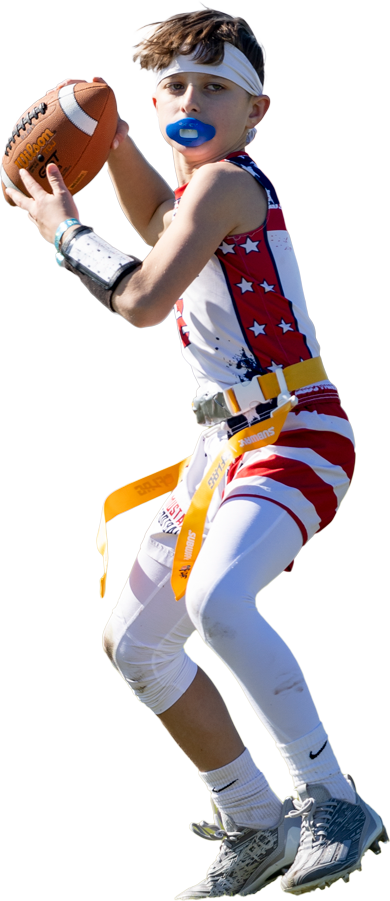

Flag football is a non-contact version of American football where tackles are replaced by pulling flags attached to a player’s waist. It focuses on agility, speed, strategy, and teamwork without the physicality and equipment of tackle football.
Olympic flag football will follow standardized international rules set by governing bodies like the International Federation of American Football (IFAF). Specific adjustments for the Olympics may include field dimensions, team sizes (typically 5v5), blitzing rules, and scoring systems. USA Flag has a format labeled the “5v5 Olympic-style” that is our equivalent of those rules tweaked for our events.
The Olympics will feature separate men’s and women’s competitions, aligning with gender equality initiatives and ensuring robust participation opportunities for both genders.
Teams will be selected through a qualification process involving national championships, regional tournaments, and international qualification events overseen by national federations and the IFAF.
Qualification will be determined through international competitions sanctioned by the IFAF, including continental championships and world tournaments. Details and pathways will be clearly outlined by IFAF and respective National Olympic Committees (NOCs).
The IOC typically requires athletes to be at least 16 years old during the Olympic year, though specifics will depend on IFAF and IOC guidelines for flag football. Exceptionally skilled younger players may potentially compete if age criteria are met.
Yes, NFL players and professional athletes are eligible, as long as they meet their nation’s Olympic qualification and selection standards. Flag football rules and style of play may require adjustments from tackle football.
Flag Football will debut at the 2028 Olympic Games in Los Angeles, USA.
The International Olympic Committee typically has no strict minimum age, but National Olympic Committees often establish age guidelines. Generally, athletes are teenagers or older, with specific ages depending on national selection processes.
Players will need flag belts, flags, official game footballs, pocketless shorts, mouthguards, cleats, and uniforms meeting Olympic standards. Optional equipment includes gloves and soft-shell helmets.
Athletes must participate in sanctioned national and international tournaments, attend selection camps hosted by national governing bodies, and meet qualification criteria set by their country’s National Olympic Committee.
Olympic sports are reviewed regularly. Typically, decisions about inclusion for future Games (such as 2032 in Brisbane, Australia) will occur around 2029 or 2030, following the assessment of the sport’s success at Los Angeles 2028.
USA Flag actively supports international growth by assisting other countries in developing national programs, offering coaching and officiating certifications, consulting on league operations, and hosting global events like the Tampa World Championships.
Participating in USA Flag tournaments such as the 2026 Tampa World Championships and other sanctioned events helps athletes compete at elite levels, gaining critical experience against international competition and exposure necessary for Olympic consideration.
The Tampa World Championships is a premier global flag football tournament organized by USA Flag, offering top-level competition and talent exposure. Participation helps players gain international experience, showcase their skills, and earn points towards national team selection. It set a Guinness World Record in 2025 as the largest flag football tournament in the world, and annually hosts over 100+ International teams and over 1,300 total youth and adult teams at it’s festival style event to end the season every January.
The inclusion in the 2032 Olympics will depend on the success and reception of flag football in 2028. The decision by the IOC will likely come in the year following the 2028 Games.
Olympic Flag Football games are likely to feature two 20-minute halves, with a running clock and a short halftime. The format will typically start with round-robin group play followed by knockout rounds leading to medal matches.
Yes, Olympic inclusion will significantly boost flag football’s profile, encouraging more colleges and universities, particularly in the United States, to offer scholarships. Professional and semi-professional leagues are also likely to expand globally.
Visit usaflag.org for comprehensive rules, training resources, practice drills, and tournament information that can enhance your Olympic preparation and understanding of international standards.